Description
The site, dating from the 2nd millennium BC, is a sanctuary village, one of the best conserved of the Nuragic Sardinia, consisting of a hundred or so of circular huts, simple or even complex and clustered in isolation, and two sacred areas surrounded by sacred fences that separate them from the dwelling, inside which there are two temples of the megaron type.
It was excavated between 1936 and 1938 by Doro Levi. Subsequently, in 1961, the site was restored under the direction of Guglielmo Maetzke.
Doro Levi (1899–1991) was an archaeologist who practiced in the Mediterranean countries in the 20th century. Specifically, Levi conducted excavations in Italy, Greece, and Turkey. From 1938 to 1945, Levi was a member of the Institute for Advanced Study in Princeton, New Jersey. Levi has published a number of technical manuscripts on archaeology such as Festos e la Civiltà Minoica, tavole I published in 1976. Some of Levi's most significant work was a long term excavation at Minoan Phaistos, which site is the second most significant Minoan settlement and which has yielded important finds such as the Phaistos Disk and extensive Bronze Age pottery.
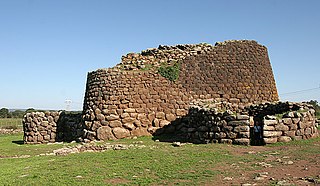
The nuraghe is the main type of ancient megalithic edifice found in Sardinia, developed during the Nuragic Age between 1900 and 730 B.C. Today it has come to be the symbol of Sardinia and its distinctive culture, the Nuragic civilization. More than 7000 nuraghes have been found, though archeologists believe that originally there were more than 10,000.

Cala Gonone is an Italian seaside town and a civil parish (frazione) of the municipality (comune) of Dorgali, Province of Nuoro, in the region of Sardinia. In 2007 it had 1,279 inhabitants.

Giants' tomb is the name given by local people and archaeologists to a type of Sardinian megalithic gallery grave built during the Bronze Age by the Nuragic civilization. They were collective tombs and can be found throughout Sardinia, with 800 being discovered there.

Su Nuraxi is a nuragic archaeological site in Barumini, Sardinia, Italy. Su Nuraxi simply means "The Nuraghe" in Campidanese, the southern variant of the Sardinian language.

Nuragus is a small town, in administrative terms a comune (municipality), in the Province of South Sardinia in the Italian autonomous region of Sardinia, located about 60 kilometres (37 mi) north of the local capital Cagliari.
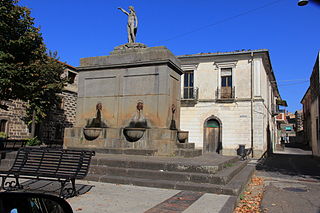
Paulilatino is a comune (municipality) in the Province of Oristano in the Italian region Sardinia, located about 100 kilometres (62 mi) northwest of Cagliari and about 25 kilometres (16 mi) northeast of Oristano.

The Supramonte is a mountain range located in central-eastern Sardinia, Italy. It lies northeast of the Gennargentu massif, traveling eastwards until it reaches the Tyrrhenian Sea at the Gulf of Orosei. It has an area of about 35,000 hectares, encompassing most of the territories of the comuni (municipalities) of Baunei, Dorgali, Oliena, Orgosolo and Urzulei. The populated areas of these comuni lie at the borders of the Supramonte, which, for the most part, is a largely uninhabited area of sharp limestone cliffs and deep, lush canyons.
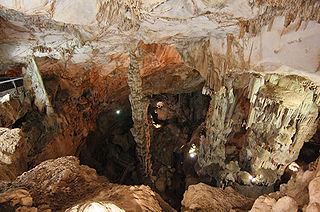
The Grotta di Ispinigoli is a karst cave in the Supramonte range, near Dorgali, Sardinia, Italy.

The Nuragic civilization, also known as the Nuragic culture was a civilization or culture on the island of Sardinia, the second largest island in the Mediterranean Sea, which lasted from the 18th century BCE to 238 BCE when the Romans colonized the island. Others date the culture as lasting at least until the 2nd century CE or possibly even to the 6th century CE.
Sardinia is the second largest island in the Mediterranean Sea and an autonomous region of Italy. Tourism in Sardinia is one of the fastest growing sectors of the regional economy. The island attracts more than a million tourists from both Italy, from the rest of Europe, and, to a lesser degree, from the rest of the world. According to statistics, tourist arrivals in 2016 were 2.9 million.

The Giants of Mont'e Prama are ancient stone sculptures created by the Nuragic civilization of Sardinia, Italy. Fragmented into numerous pieces, they were found by accident in March 1974, in farmland near Mont'e Prama, in the comune of Cabras, province of Oristano, in central-western Sardinia. The statues are carved in local sandstone and their height varies between 2 and 2.5 meters.

Tiscali Village is an archaeological site situated in Sardinia, in the comune of Dorgali.

The Sacred pit of Garlo is an archaeological site located near the village of Garlo in Pernik District, Bulgaria.
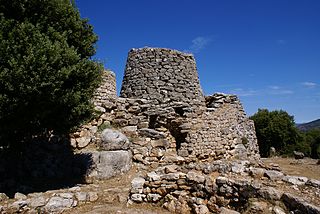
The nuraghe Serbissi is a nuragic complex dating back to 18th-10th century BC. It is located in the municipality of Osini in Ogliastra, Italy.

Nuraghe Mannu is a nuragic archaeological site located about 180 metres (590 ft) above sea level overlooking the village of Cala Gonone. It is located on the east coast of Sardinia, in the middle of the gulf of Orosei, province of Nuoro and the municipality of Dorgali. The Nuraghe is partially visible from below and from the coast, from the top it gives a clear view over the surrounding area.
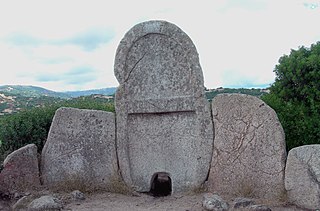
The giants' grave of S'Ena'e Thomes is a nuragic-era archaeological site located in the municipality of Dorgali, in the province of Nuoro, Sardinia.
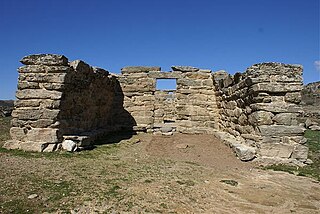
The megaron temple of Domu de Orgia is an important nuragic archaeological site located in the territory of Esterzili, in the Province of South Sardinia.

The nuragic sanctuary of Gremanu is a sacred nuragic area located in the territory of Fonni, in the province of Nuoro.

















